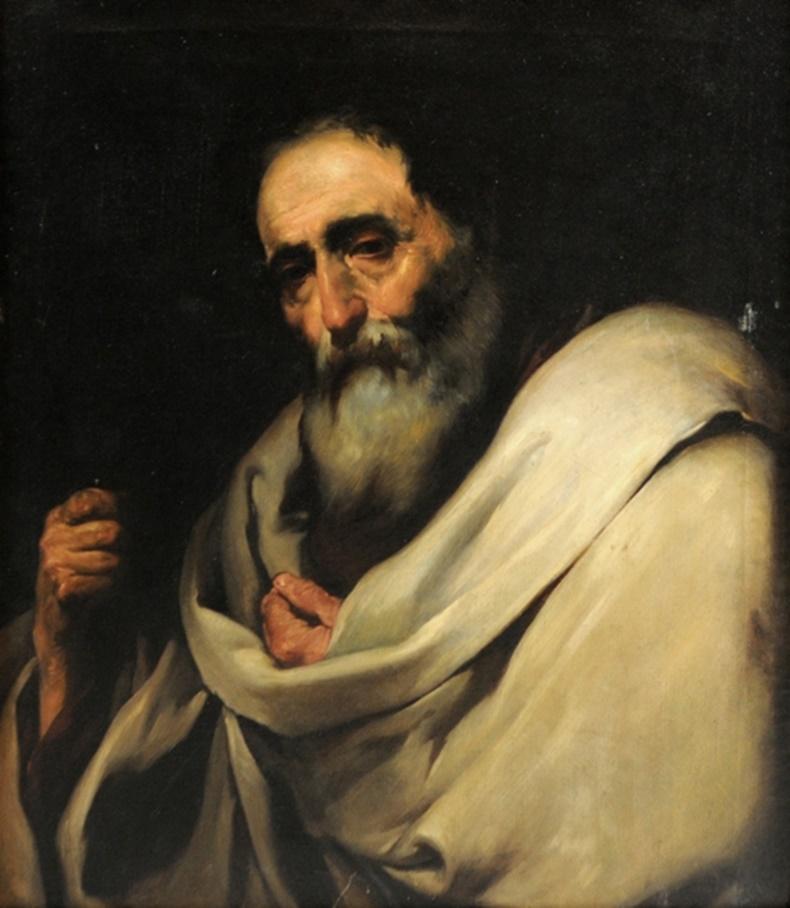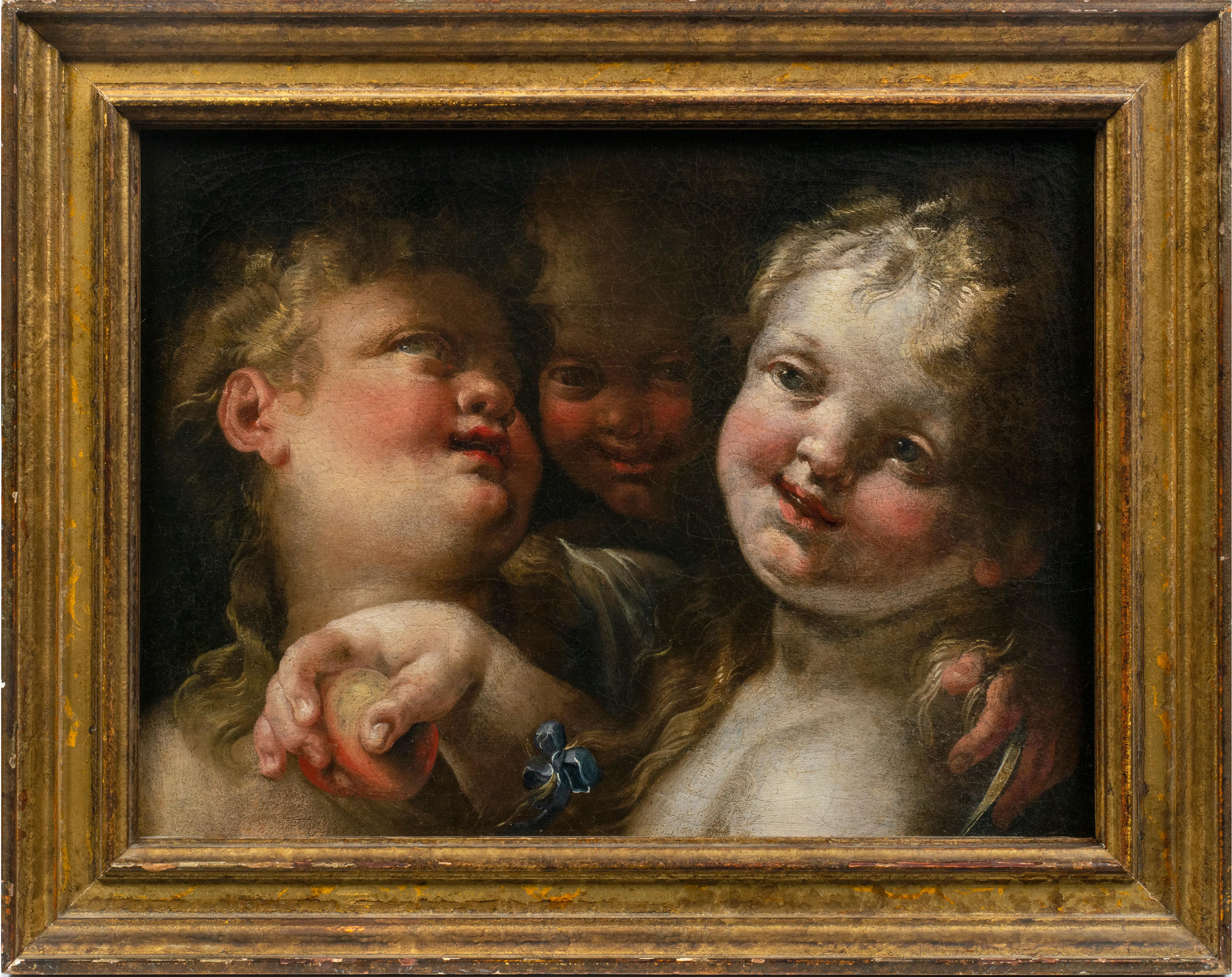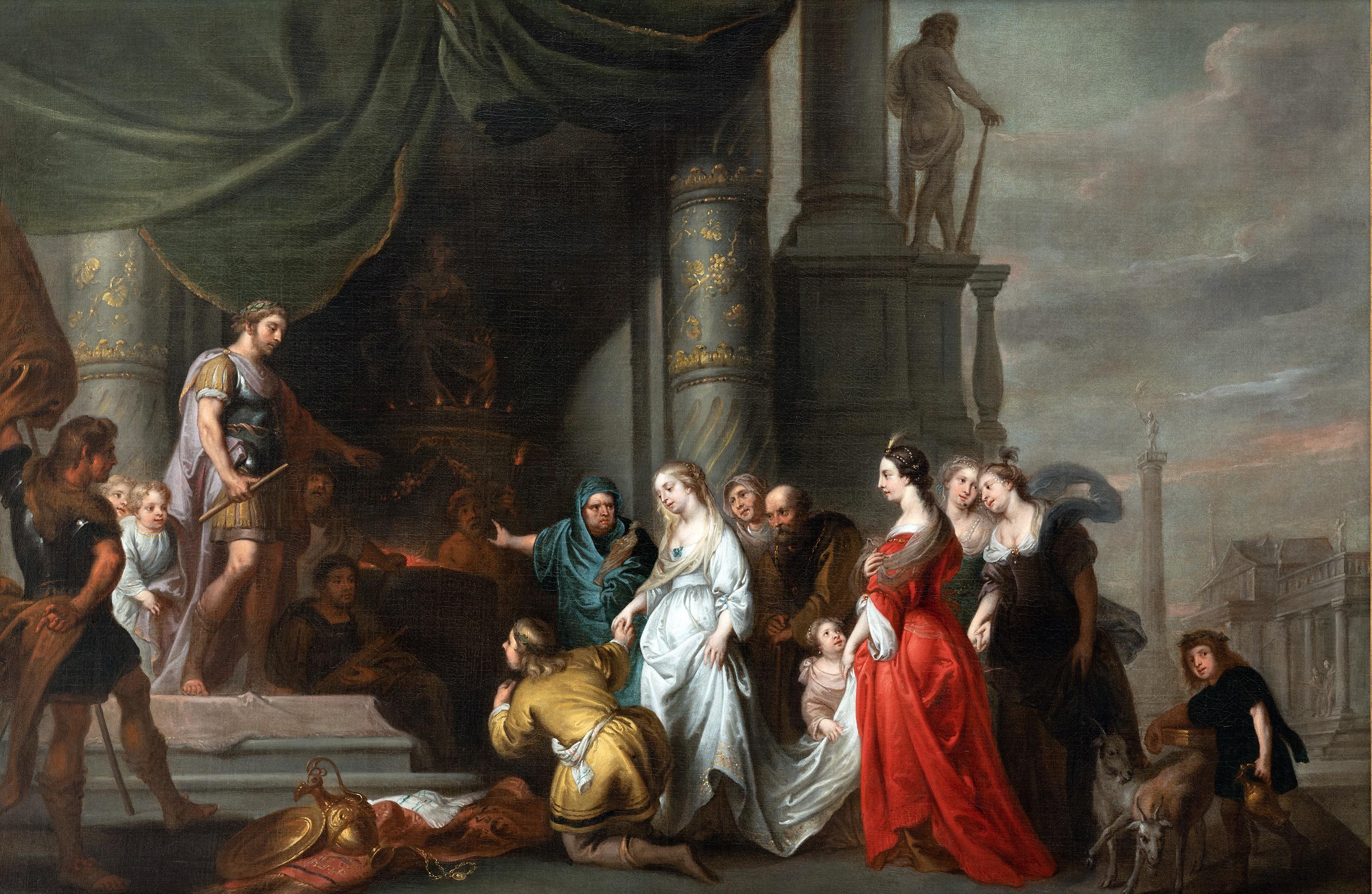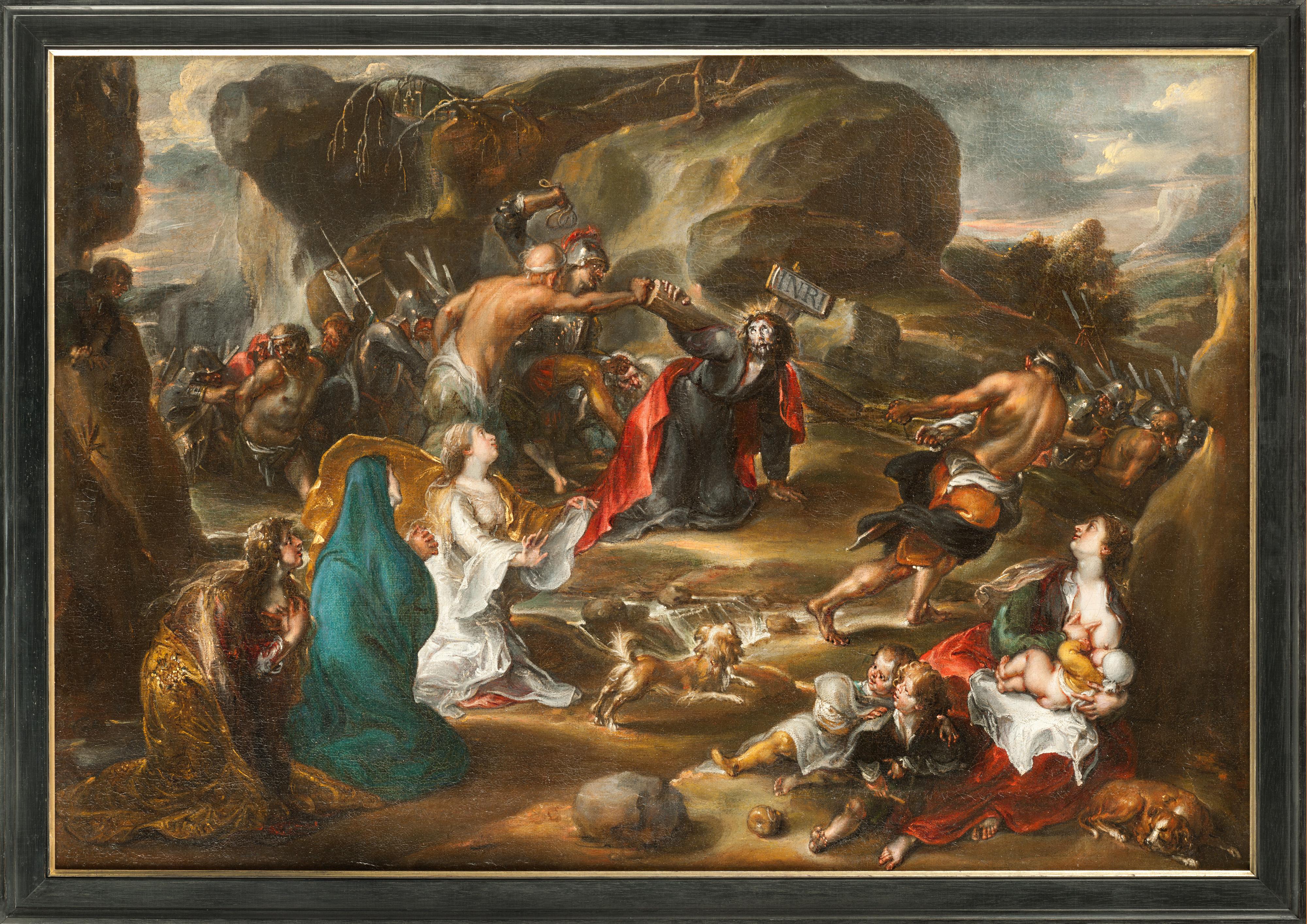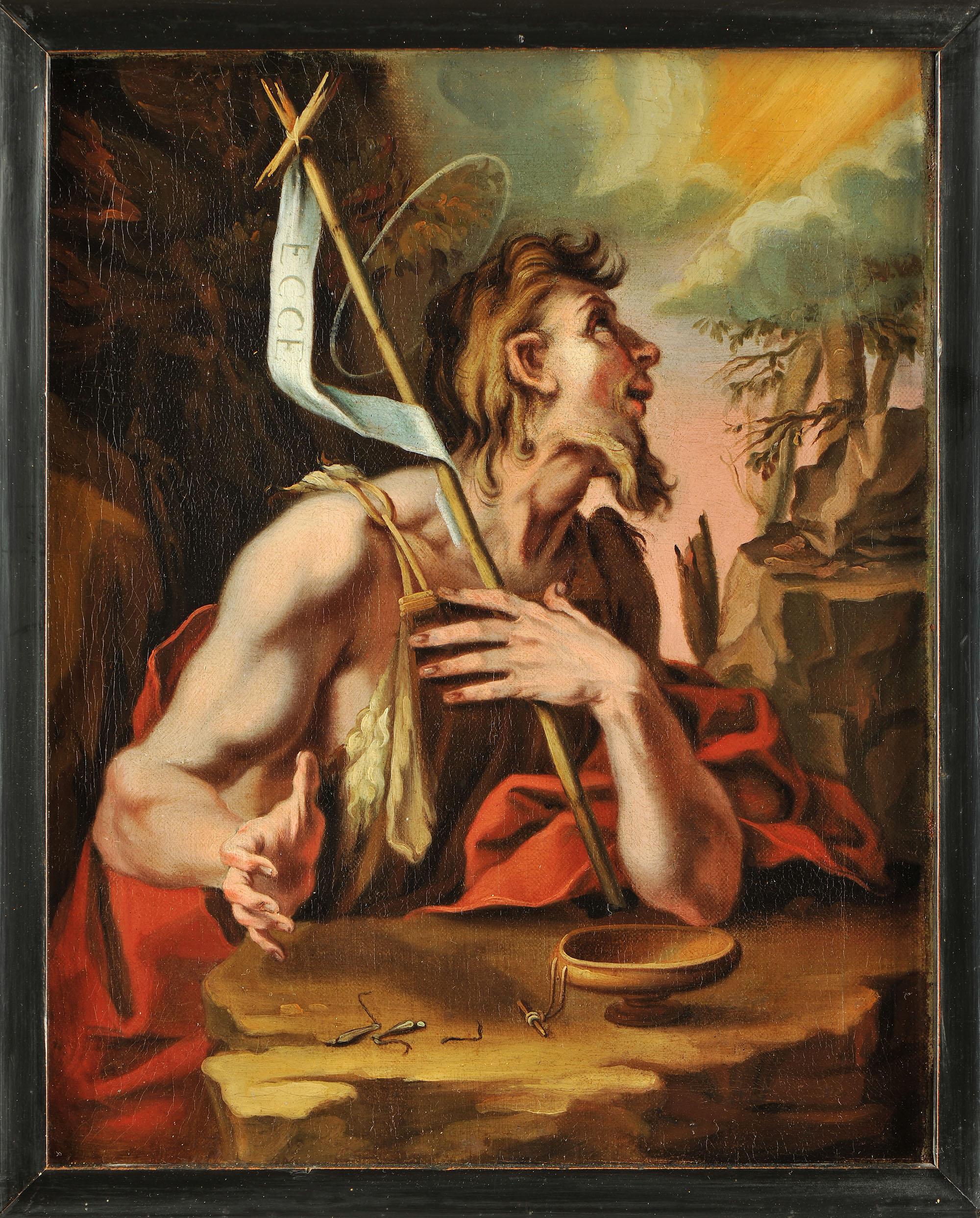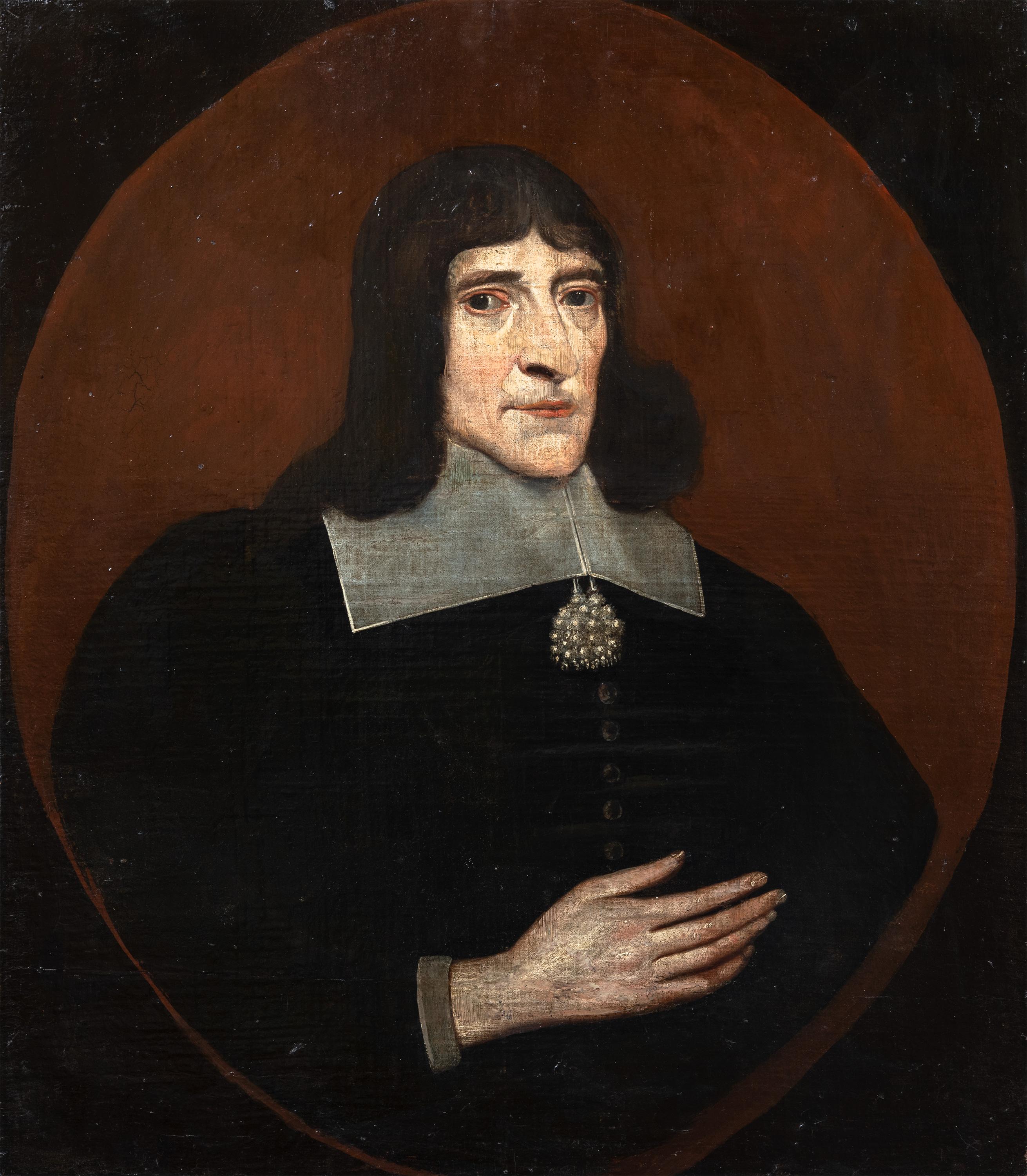Items Similar to To the Calvary with Madaleine - Oil on Canvas by Ippolito Borghese - Early 1600
Want more images or videos?
Request additional images or videos from the seller
1 of 5
Ippolito BorgheseTo the Calvary with Madaleine - Oil on Canvas by Ippolito Borghese - Early 1600Early 1600
Early 1600
About the Item
To the Calvary with Maddalena is a superb and impressive original oil painting on canvas, realized by the Italian artist Ippolito Borghese (Sigillo, 1568 - after 1627)
Original Title: Andata al Calvario con l'incontro con la Maddalena e Porta Capuana sullo sfondo (Went to the Calvary with the meeting with Maddalena and Porta Capuana in the background).
Signature not completely readable on the column of the background "Hyp B(..)e faciebat".
The author of the painting can be identified in the person of Ippolito Borghese, a talented artist of Umbrian origin active mainly in Naples.
As regards the dating of execution of this artwork it could be fixed around the first years of XVII century in the Neapolitan city, as the background demonstrates with the detail of Capuana Door.
This a rare artwork with this subject realized from the very limited Borghese's production. There is another, and the unique known, Borghese's artwork, "Went to the Calvary" in the Madonna del Rosario e Santi Church in Rogoledo di Cosio, executed in 1606.
During the first two decades of the seventeenth century Borghese's painting in Naples appears as the most purified and daily version of naturalism. Comparing his production to that by Caravaggio, we understand that his artworks were suited to the demands of the religious commissioners of altarpieces.
Reference bibliography: P. L. de Castris, La pittura del Cinquecento a Napoli (1573-1606). L'ultima maniera, 2001, pp. 285-316; F. Ferrante, Ricerche su Ippolito Borghese, in "Prospettiva", fasc. 40, 1985, pp. 20-36.
Expertise by Dr. Patrizio Basso Bondini date November, 2019.
This artwork is shipped from Italy. Under existing legislation, any artwork in Italy created over 70 years ago by an artist who has died requires a licence for export regardless of the work’s market price. The shipping may require additional handling days to require the licence according to the final destination of the artwork.
- Creator:Ippolito Borghese (1568 - 1627, Italian)
- Creation Year:Early 1600
- Dimensions:Height: 44.3 in (112.5 cm)Width: 34.26 in (87 cm)Depth: 0.99 in (2.5 cm)
- Medium:
- Movement & Style:
- Period:Early 17th Century
- Framing:Framing Options Available
- Condition:Insurance may be requested by customers as additional service, contact us for more information.
- Gallery Location:Roma, IT
- Reference Number:
About the Seller
4.9
Platinum Seller
These expertly vetted sellers are 1stDibs' most experienced sellers and are rated highest by our customers.
1stDibs seller since 2017
6,693 sales on 1stDibs
Typical response time: 2 hours
- ShippingRetrieving quote...Ships From: Rome, Italy
- Return PolicyA return for this item may be initiated within 14 days of delivery.
More From This SellerView All
- The Tooth-Puller (Il Cavadenti) - Oil on Canvas by Follower of CaravaggioBy Follower of Caravaggio (Michelangelo Merisi)Located in Roma, ITThe Tooth-Puller is a superb original oil painting on canvas, realized by an anonymous artist, a follower of Caravaggio, in the first half of the X...Category
Late 17th Century Baroque Figurative Paintings
MaterialsCanvas, Oil
- Still Life with fruits - Oil Paint On Canvas - 17th CenturyLocated in Roma, ITStill Life with fruits is an original oil on canvas realized in the 16th Century by an Italian School Master. Original oil painting on Canvas. The painting represents a still life...Category
17th Century Baroque Still-life Paintings
MaterialsOil, Canvas
- Interior Scene with Kitchen - Oil on Canvas - 1659Located in Roma, ITSigned and dated lower left. Includes a beautiful later wooden frame cm. 137x8x182. Very Good conditions. Prov. Christie's London, February 15th 1974, n. 19. This artwork is shippe...Category
1650s Baroque Interior Paintings
MaterialsOil
- Orpheus - Original Oil on Canvas Attr. to Tommaso Salini - Early 17th CenturyBy Tommaso SaliniLocated in Roma, ITOrpheus is an original artwork realized in the first decades of the XVII century and attributed to the Italian master Tommaso Salini. Oil painting on canvas. A golden wood frame is...Category
Early 17th Century Baroque Figurative Paintings
MaterialsOil
- The Knight - Oil on Board by Pietro della Vecchia - 17th CenturyBy Pietro della VecchiaLocated in Roma, ITThe Knight is an original painting realized by Pietro della Vecchia during the XVII century. Oil on board. Original title: Ritratto di giovane cavaliere con cappello piumato. Includ...Category
Mid-17th Century Baroque Figurative Paintings
MaterialsOil
- Pair fo Still Lives - Oil on Canvas by N. Stanchi - Late 17th CenturyBy Niccolò StanchiLocated in Roma, ITBeautiful pair of still lives ascribed to N. Stanchi, realized in the second half of 17th century. Both in very good conditions, they include a contemporary wooden gilded frame. Dime...Category
Late 17th Century Baroque Still-life Paintings
MaterialsOil
You May Also Like
- Saint Bartholomew, Old Master, Oil Print, Ribera, Figurative Art, Spanish ArtBy Jusepe de RiberaLocated in Greven, DEOld Master An Oil Print after a Painting by Jusepe de Ribera in the Museo del Prado, Spain. This is an early print after the original.Category
20th Century Baroque Figurative Prints
MaterialsOil, Canvas
- Three AngelsBy Domenico Piola the ElderLocated in New York, NYProvenance: Robert L. and Bertina Suida Manning, New York, until 1996 Private Collection, USA One of the leading artists in Genoa during the second half of the seventeenth century, Domenico Piola came from a successful family of artists, renowned for their many illusionistic ceiling programs throughout Genoese churches and palaces. A prolific draughtsman and painter, Domenico oversaw an extremely productive studio. In addition to his collaborations with numerous other artists, Domenico also provided many designs for book illustrations and prints that circulated throughout Europe, earning him international exposure and high acclaim in his own day. As Dr. Anna Orlando has indicated (written communication), the present work is an early work by Piola, datable from the late 1640s. At this time the young artist came strongly under the influence of Castiglione and Valerio Castello, while admiring the works of Giulio Cesare Procaccini. Piola’s works from this period are exuberant and fluid, and the artist’s love of portraying children is evident from the angels and putti that populate both his altarpieces and more intimate paintings. The present work depicts three angels...Category
17th Century Baroque Figurative Paintings
MaterialsCanvas, Oil
- Continence of Scipio, Erasmus Quellinus, School Rubens, Baroque Art, Old MasterBy Erasmus Quellinus the YoungerLocated in Greven, DEErasmus Quellinus The Continence of Scipio Oil on Canvas The painting is included in the Catalogue Raisonné of the artist. The Roman commande...Category
17th Century Baroque Figurative Paintings
MaterialsOil, Canvas
- Christ Carrying the Cross, Old Master, Flemish, De Vos, Religious Scene, RubensBy Simon de VosLocated in Greven, DEThe scene of Christ carrying the cross is imagined in a rocky landscape. Two soldiers press the cross onto his shoulders, another leads him, holding the rope. A line of soldiers and prisoners moves from right to left. In front of them the three Marys kneel and pray for Christ. A nursing woman, symbol of Caritas, sits in the right foreground. Some dogs and playing kids enliven the scenery. Simon de Vos was born in Antwerp, and was first taught by Cornelis de Vos...Category
17th Century Baroque Figurative Paintings
MaterialsCanvas, Oil
- Fenzoni, Painting AND preparatorial Drawing, John the Baptist, Italy RenaissanceBy Ferrau FenzoniLocated in Greven, DEThe painting and the preparatory drawing are offered together. Provenance Private collection, Germany, Trier, c. 1980- 2013 Saint John the Baptist Brown ink and wash over red chalk on oatmeal paper 31 x 20.5 cm Inscribed: „Ferrau Fenzonio da Faenza invt. esque … imp. da Fran. Villamena …“. bears the collector's mark of Henry Scipio Reitlinger (1882-1950; Lugt 2274a) on a tiny label glued to the verso On the reverse is a partial drawing of a Pieta, pricked for transfer. Provenance New York, Doyle, 14. October 2015, No. 6 The painting and the preparatory drawing resemble the composition of an engraving after Ferraù Fenzoni by Francesco Villamena. Drawing, engraving and painting are almost identical, except for minor differences. Even the measurements nearly correspond: painting (32 x 25,5 cm), drawing (30 x 20,5 cm), engraving (31,1 x 23,5 cm). Dr. Guiseppe Scavizzi confirmed the attribution of the present panting to Fenzoni and he dates it to c. 1590. The inscription on the drawing reads “Ferrau Fenzonio da Faenza invt. esque. . . imp. da Fran: Villamena . . .”. The engraving’s inscription also lists place and date “Ferra Fensionius inventor/F. Villamoena sculpsit Rome/Aspectu fruitur… antra puer/cum Privilegio… 1613”. Interestingly, the engraving is not mirrored as it is in most printing processes. Painting, drawing and engraving are not reversed but the same. It is remarkable to note that there are further paintings by Fenzoni which were engraved in the same order and not reverted. They also show strong parallels regarding the compositions and the measurements (see for example “Deposition of Christ” ). Ferraù Fenzoni was an Italian painter mainly active in Todi. He is also called Il Faenzone after his birthplace (Faenza). He apprenticed in Rome during the papacy of Gregory XIII and contributed to numerous fresco cycles under pope Sixtus V, such as the Loggia della Benedizioni in the Lateran Palace, the frescoes on the walls and vaults of the Scala Santa of the adjacent Basilica of San Giovanni in Laterano, and the decoration in the Sistine library. His expressive canvases straddle the styles of Mannerism and Baroque. In 1594, he moved to Todi. A “Last Judgement” by him is housed in the cathedral of Todi. He returned to Faenza in 1599, where he decorated chapels in the cathedral from 1612 to 1616. In 1622, he completed a “Deposition”, now in the local Pinacoteca. In 1640, Fenzoni was named “cavaliere dello speron d’oro” by Cardinal Colonna and, on 25th April 1634, he was nominated vicar and “castellano of Granarolo”. Fenzoni‘s style is characterized by a mixture of the Mannerism of the Northern Netherlands and the Italian Baroque. Saint John the Baptist, Old Master, 17th Century, By Fenzoni, Religious Scene, Rome Art...Category
16th Century Mannerist Figurative Paintings
MaterialsCanvas, Oil, Handmade Paper
- 17th century English figure painting - Portrait nobleman - Oil on canvasLocated in Varmo, ITEnglish painter (17th century) - Portrait of a gentleman. 73.5 x 63.5cm. Oil on canvas, unframed. Condition report: Canvas applied on panel. Good state of conservation of the pict...Category
Mid-17th Century Baroque Portrait Paintings
MaterialsCanvas, Oil
Recently Viewed
View AllMore Ways To Browse
Oil Canvas Baroque
Oil Painting From Early 20 Century
Original Baroque Painting
Art Xvii Century
Antique Door Handles Black
Oil Caravaggio
Oil Painting Caravaggio
17th Century Early Baroque Painted
Altarpiece Painting
Oil Paintings 1600
Of Rare Origin
1600 Oil Paint
Italian Painting 1600
After Caravaggio
Painting After Caravaggio
Xvii Century Paint
36 Door
F E Church
